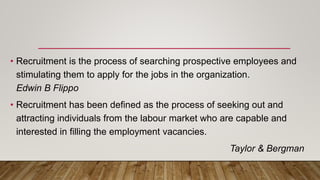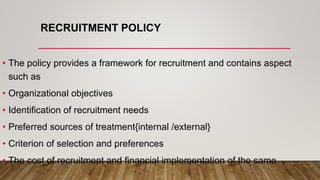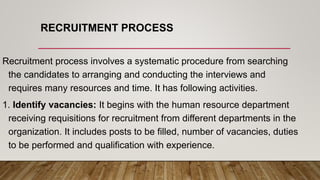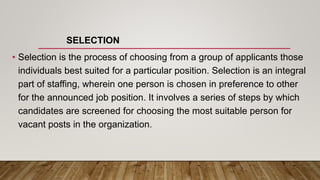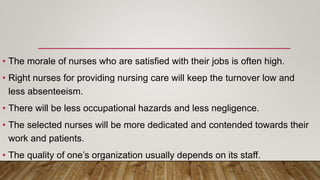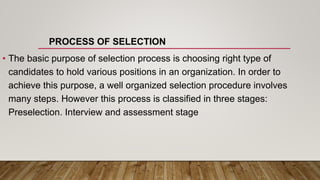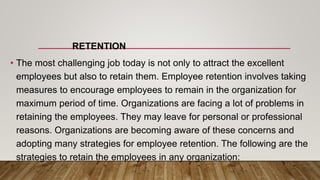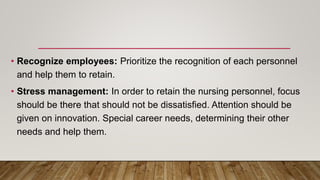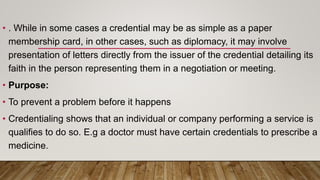Recruitment
- 1. RECRUITMENT, SELECTION, PLACEMENT PROMOTION, CREDENTIALING AND RETENTION ULFAT AMIN MSC PEDIATRIC NURSING
- 2. RECRUITMENT DEFINITION • Recruitment is the process of finding and attracting capable applicants for employment. The process begins when new recruits are sought and ends when their applicants are submitted. William B Werther &K.Devis
- 3. • Recruitment is the process of searching prospective employees and stimulating them to apply for the jobs in the organization. Edwin B Flippo • Recruitment has been defined as the process of seeking out and attracting individuals from the labour market who are capable and interested in filling the employment vacancies. Taylor & Bergman
- 4. PURPOSE AND IMPORTANCE OF RECRUITMENT • Attract and encourage candidate to apply for the post in the organization. • Determine present and future requirements of the organization. • Create a pool of candidate at the low cost. • Begin identifying and preparing potential applicants who will be appropriate candidates.
- 5. FACTORS DETERMINING RECRUITMENT • Size of the business. • Employment conditions in the locality of recruitment. • The past recruiting policy of the organization in retaining good workers. • Working environment and compensation package that influence employees to continue or take exit from the organization. • The rate of growth of the organization; future, cultural, legal and economic factors • Cost of recruitment.
- 6. RECRUITMENT POLICY • The policy provides a framework for recruitment and contains aspect such as • Organizational objectives • Identification of recruitment needs • Preferred sources of treatment{internal /external} • Criterion of selection and preferences • The cost of recruitment and financial implementation of the same
- 7. RECRUITMENT PROCESS Recruitment process involves a systematic procedure from searching the candidates to arranging and conducting the interviews and requires many resources and time. It has following activities. 1. Identify vacancies: It begins with the human resource department receiving requisitions for recruitment from different departments in the organization. It includes posts to be filled, number of vacancies, duties to be performed and qualification with experience.
- 8. • Preparing job and person specification: Job specification is helpful to think of job under broad heading; main characteristics of the training, background of the job, main responsibilities and job boundaries, experience of job holder, resources and constraints affecting the job. It has to be decided what types of candidates are to be invited and what would be their characteristics. • Advertising vacancies: This is the method by which the candidates will be located. It is either through internal sources or external sources and also decided the method of advertising for the post.
- 9. • Managing response: This step is to the way adopted to receive the applications and scrutinize each application as per the recruitment policy by the scrutiny committee. • Short listing and identifying the prospective candidates: After the scrutiny the eligible candidates are shortlisted and a list is prepared. • Arranging the interview with the shortlisted employees: Interview dates are finalized. Criteria for the merit list are prepared by the committee is formulated. • Conducting the interview and decision making: Interview is conducted on the scheduled date by the selection committee. Then the candidates are selected.
- 10. SOURCES OF RECRUITMENT • Sources of recruitment can be grouped into two categories: internal and external. Recruitment from internal sources • It is done within the organization. It includes the candidates who are already on pay rolls of the organization and also who were once on the pay roll and plan to return or whom organization would like to retire. These include: • TRANSFERS: It involves shifting from one department to another department. It does not involve any drastic change in the responsibilities, pay and status of employee. • PROMOTION: It leads to shifting of employees to a higher position,
- 11. RECRUITMENT FROM EXTERNAL SOURCES These sources lie outside the organization. These include: • ADVERTISEMENT: It is the most effective means used to search for the potential employees. Advertisements in the leading newspapers, Television ads etc help in searching the qualified and experienced personnel for vacant jobs. • ENPLOYMENT AGENCIES: Employment agencies run by government are regarded as important source of recruitment. The employment exchanges bring employees in contact with the job seekers.
- 12. • DEPUTATION: This method is also quite common. The employees of one organization are selected or taken on deputation from other organization for filling the vacancies. • ON THE CAMPUS RECRUITMENT: In this method a preliminary search for prospective employees is done by conducting interviews at the campus of various institutions, universities and colleges on predetermined dates and suitable candidate are selected. • TELECASTING: The practice of telecasting of vacant posts over TV (Doordarshan) is gaining importance these days. Special programs like ‘job watch’, ‘youth pluse’ etc over TV have become quite popular in recruitment for various types of posts.
- 13. SELECTION • Selection is the process of choosing from a group of applicants those individuals best suited for a particular position. Selection is an integral part of staffing, wherein one person is chosen in preference to other for the announced job position. It involves a series of steps by which candidates are screened for choosing the most suitable person for vacant posts in the organization.
- 14. DEFINITION • Selection is the process of differentiating between applicants in order to identify those with a greater likelihood of success in the job. • It is a process of choosing the fit candidates or rejecting the unfit candidates or combination of both.
- 15. SIGNIFICANCE OF SELECTION • The objective of selection process is to achieve the best fit between the job requirements and holders. The benefits of selecting the best fit or right candidate for various posts are as follows: • Proper selection and placement lead to build up suitable workforce. • It helps to bring competent and skilled persons and thereby higher efficiency in providing the quality care. • The satisfied nurses with positive attitude and good aptitude will initiate to fulfill the organizational goals.
- 16. • The morale of nurses who are satisfied with their jobs is often high. • Right nurses for providing nursing care will keep the turnover low and less absenteeism. • There will be less occupational hazards and less negligence. • The selected nurses will be more dedicated and contended towards their work and patients. • The quality of one’s organization usually depends on its staff.
- 17. PROCESS OF SELECTION • The basic purpose of selection process is choosing right type of candidates to hold various positions in an organization. In order to achieve this purpose, a well organized selection procedure involves many steps. However this process is classified in three stages: Preselection. Interview and assessment stage
- 18. • PRE SELECTION • This particular stage can also be covered under recruitment. This stage involves defining the job and deciding what sort of nurses are required, analizing application and short listing for interview. • INTERVIEW • The eligible candidate is then called and is evaluated according to pre determined criteria through interview, where the candidate has to face the selection committee, constituted by the organization. • ASSESSMENT • In this stage, the candidate is assessed to predict how he/she is likely to behave in future. Some practices are making use of cognitive and psychometric tests. The assessment report should end with list of strengths and limitations pointing to a final decision.
- 19. RETENTION • The most challenging job today is not only to attract the excellent employees but also to retain them. Employee retention involves taking measures to encourage employees to remain in the organization for maximum period of time. Organizations are facing a lot of problems in retaining the employees. They may leave for personal or professional reasons. Organizations are becoming aware of these concerns and adopting many strategies for employee retention. The following are the strategies to retain the employees in any organization:
- 20. • Selecting and training: After selecting the nurses, the organization must initiate policies to invest in the development of their skills through training. These programmes help in reducing the skill gaps for new employees. Training helps the employees to adjust to rapidly changing job requirement and it builds satisfaction and trust. • Effective orientation: It helps the nursing personnel to understand the work environment and organization. It also helps in producing good working relationships and to adjust with new environment.
- 21. • Job satisfaction: Lower job satisfaction translates into higher resignation rate with resulting loss of valuable competent nurses. If they are satisfied, they will become loyal and retain for longer time. • Creating trust: The most effective way of building trust in the workplace is to work together through team work, honesty and fairness. It will form the foundation for effective communication and motivation.
- 22. • Empower each nursing personnel: It is essential to empower each employee in the organization irrespective of her position in the hierarchy to create a sense of belongingness in each member. Each staff will enjoy autonomy while doing the job and ensure accountability. • Built relations with subordinates: Develop healthy relationship with subordinates and create a family like feeling within the organization. Try to motivate them by providing good facilities for work, value their ideas and recognize their work.
- 23. • Recognize employees: Prioritize the recognition of each personnel and help them to retain. • Stress management: In order to retain the nursing personnel, focus should be there that should not be dissatisfied. Attention should be given on innovation. Special career needs, determining their other needs and help them.
- 24. • PLACEMENT • Placement may be defined as ‘the determination of the job to which an accepted candidate is to be assigned’ and his assignment to that job. A proper placement of workers reduces employee turnover, absenteeism and accident rates and improves morale
- 25. • EFFECTIVE PLACEMENT: Placement can be made effective in the following ways: • Job rotation: This enables an employee to satisfy his aptitude for challenging work. • Team work: This allows the employee to use their skills, knowledge etc thereby minimizing the problems in placement. • Training and development: Continuous training and development programmes help employees acquire new skills and knowledge. • Job enrichment: This gives the opportunity of utilizing the varied skills of the employees and minimizing problems in management. • Empowerment: Empowering employees makes the employer exploit their potentialities and most effectively make use of them.
- 26. PROMOTION • Promotion comes from the Latin word Promover meaning to move forward. A promotion is the transfer of an employee to a job which pays more money or one that carries some preferred status.” Scott and Clothier’ • Promotion is an advancement of an employee to a better job better in terms of greater responsibility, more prestige and status, great skill and specialty increased rate of pay or salary. Pigers and Mayers
- 27. PURPOSE • To motivate employee to higher position. • To attract and retain the competent and cream employee. • To recognizing and reward deserving and competent employee. • To increase the effectiveness and efficiency of capable employee and organization. • To fill higher vacancies within organization • To build morale and belongingness among the employees. • To provide opportunities to the employees to grow within organization.
- 28. BASIS OF PROMOTION • Seniority: It means promotion of an employee to a higher position on the basis of length of service. Seniority as a basis of promotion provides an objective criterion and prevents arbitrary selection or favoritism. It develops a sense of loyalty to the organization, reduces employee turnover and minimizes disputes on promotion. However it does not provide no incentive for improved performance thus it tends to demoralize competent persons leading to higher turnover and mobility.
- 29. • Merit system: It is just the opposite to the principles of seniority. It provides due incentives to the employees for continues development in work performance. This adds positively to overall organizational effectiveness and success. The limitation of this policy is that it is difficult to assess the merit objectively and leaves a wide scope for favoritism. • Seniority cum merit system: This is the most widely used basis of promotion. This system combines both seniority and merit system for promotion process.
- 30. CREDENTIALING • Credential is an attestation of qualification, competence, or authority issued to an individual by a third party with a relevant or assumed competence to do so. • Examples: Academic diplomas, academic degrees, certifications, security clearances, identification documents, badges, passwords, user names, keys, powers of attorney, and so on.
- 31. • Sometimes publications, such as scientific papers or books, may be viewed as similar to credentials by some people, especially if the publication was peer reviewed or made in a well known journal or reputable publisher. • A person holding a credential is usually given documentation or secret knowledge (e.g., a password or key) as proof of the credential. Sometimes this proof (or a copy of it) is held by a third, trusted party.
- 32. • . While in some cases a credential may be as simple as a paper membership card, in other cases, such as diplomacy, it may involve presentation of letters directly from the issuer of the credential detailing its faith in the person representing them in a negotiation or meeting. • Purpose: • To prevent a problem before it happens • Credentialing shows that an individual or company performing a service is qualifies to do so. E.g a doctor must have certain credentials to prescribe a medicine.
- 33. SUMMARY
- 34. BIBLIOGRAPHY 1. DEEPAK.K, SARATH CHANDRAN,C, MITHUN KUMAR.BP, A comprehensive text book on nursing management, page 190- 204 2.


